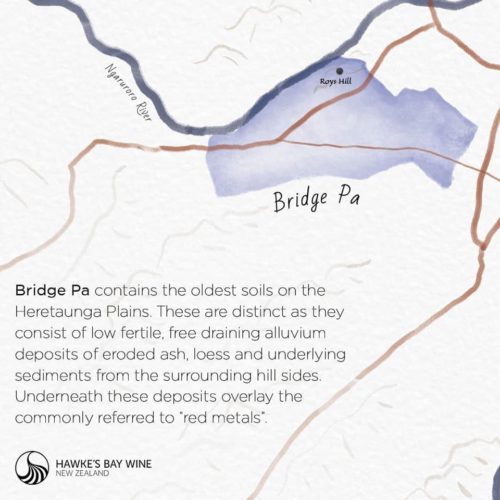Bridge Pa Triangle Vineyard
Our vineyard lies in the Bridge Pa Triangle sub-region of Hawkes Bay on the old Ngaruroro riverbed. From these red metal alluviale soils, Abbey Cellars produces world-class wines from a wide range of varietals including -
- Merlot
- Cabernet Sauvignon
- Malbec
- Cabernet Franc
- Riesling
- Chardonnay
- Vigonier
- Petit Verdot
- Carménère
- Pinot Gris
- Syrah
Abbey Cellars is 20 kilometres inland from the Hawke's Bay coast which results in a unique climate.
Located in the Bridge Pa Triangle, Hawke’s Bay, on 13 hectares of silted red metal soils, now sits a single estate winery, proud to be making some of the best wine New Zealand has to offer.
The character of Bridge Pa Triangle soils lends strong exponents of blackberry, raspberry, and eastern spices, not to mention the influence of early ripening.

Bridge Pa Triangle Region
Bridge Pa Triangle is a grape growing area roughly delineated by three roads: Ngatarawa Road, State Highway 50 and Maraekakaho Road. It is recognised as a premium wine growing area in the Hawke’s Bay region. In ancient times the area was blanketed by the pumice tephra of numerous Taupo volcanic events. Much of the Triangle area covers the historical (pre-1860s earthquake) riverbed of the nearby Ngaruroro River. As such soil types include Ngatarawa Gravels, Takapau Silty-loam (free draining red metal of mixed alluvial and volcanic origin) and shallow clay-loam soils with underlying deep free draining pumice.
It is the special nature of the soils here that provide depth and flavour to the resulting wines, based on free-draining “red metal” gravels overlaid by alluvium derived from loess, volcanic ash and greywacke. The combination of these special soils with high sunshine hours, low rainfall and Growing Degree Days comparable to Bordeaux makes the Bridge Pa Triangle a unique viticultural area.
Bridge Pa Triangle Soils
The Bridge Pa Triangle Wine District contains the oldest soils on the Heretaunga Plains, formed over thousands of years by the changing course of the lower Ngaruroro River. It is characterised by three main soil types: the Takapau and Ngatarawa series are both sandy loam over gravel, while the eastern border along Ngatarawa Road is primarily Te Awa clay loam on pumice sand. All three are free-draining, warm soils overlying “red metal” alluvial gravels that are ideally suited to viticulture, with sufficient water holding capacity to give balanced vines with only limited irrigation.
[video_preview post_url="www.youtube.com/watch?v=ArABHWxKYxY&t=29s" title="no" date="no" author="no" lightbox="no"]